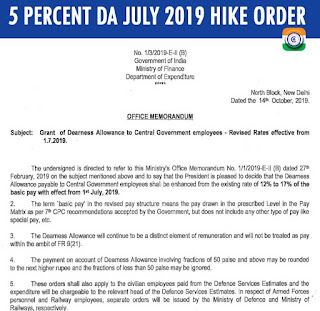7th pay panel’s draft report riddled with dissent notes
The seventh Pay Commission’s draft report to determine the new salary
structure for the 5.5 million civil servants in the central government
has got riddled with several dissent notes. The notes, mainly about
bringing in parity between the top-ranked Indian Administrative Service
(IAS) and the specialised central services, argue that it will widen the
talent base available to the government to deliver increasingly complex
services to a demanding population.
But the dissensions could exacerbate differences at the top of the
bureaucracy in the Government of India, already reeling from the impact
of pay-related problems for the retired armed forces personnel who have
demanded ‘one rank one pension’.
“There is a strong case for considering talent in the government
rather than being confined to choices within some cadres,” former
expenditure secretary Dhirendra Swarup told Business Standard. Swarup is
one of the few non-IAS officers who became secretaries in the
government, under former finance minister Jaswant Singh.
The notes are also a first for the Pay Commissions, set up every 10
years by the central government to revise the pay and allowances of
central government employees. In the fifth Pay Commission, economist
Suresh Tendulkar had put in a dissent note but it was on a macro theme
suggesting a pruning of the bureaucracy and relating wages to
performance.
But this time the notes reflect the sharp differences that have come
up among the different cadres of government services about their pay and
promotion avenues. There is a larger issue here. All the services taken
together make up fewer than 150,000 people within the central
government tasked with a mammoth level of administrative responsibility
for a country of 1.3 billion people. So, frustrations among them could
have far-reaching repercussions.
These men and women operate in a rigidly differentiated world through an
appointment system that places them in cadres. The cadres almost mirror
the caste differences in the larger society. The top-most cadres are
the all-India services that include the IAS, Indian Police Service and
Indian Forest Service. Of them, the IAS are the most numerous, at 4,572
according to the Civil Survey Report of 2010, written by former cabinet
secretary, K M Chandrasekhar.
Below them are about 45 cadres clubbed as central civil services, which include the IFS, IA&AS and IRS.
The impact of this pecking order came out in the open recently in the
list of empanelled officers for the post of 60 additional secretaries.
These posts rank just one notch below that of the secretaries, who
function as heads of department or ministries in the government. Of
those empanelled, only three (railways, income tax and audit &
accounts services) were from the non-all India services. Swarup said the
numbers were even lower than those until the 1990s, when there were at
least five non-IAS officers in the central government ministries. At
joint secretary and senior levels, positions up to those of secretaries
(senior administrative grade) in central ministries, the share of other
services is minuscule when compared with IAS. Yet, this is where
policies are shaped.
At the heart of the difference is a two-year increment offered to IAS
officers when they join vis-a-vis other cadres. Since seniority within
the government is decided on pay scale, the higher start assures these
officers of a higher position at each grade. But as the IRS officers and
others in their representations have pointed out, this makes it
impossible for them to compete for additional secretary and secretary
posts in the ministries.
But Chandrasekhar counters it saying officers from most non-IAS
services have enough options to be promoted within their services.
“There is need for both specialists and generalists in the civil
services. The Indian government is a massive structure that demands many
different skill sets”.
To correct some of the problems, the 2010 report had suggested
setting up of a Central Civil Services Authority for officers from all
the services after they completed 13 years of service. Each officer
would get to choose an area of specialisation for the rest of their
career. It has not been implemented so far.
The report of the Pay Commission, headed by Ashok Kumar Mathur, a
former judge of the Supreme Court, was held up due to Bihar Assembly
polls. The commission was given a four-month extension in August.
Besides Mathur, the others in the commission are Vivek Rae (IAS) as
full-time member, besides part-time members Meena Agarwal (Indian
Railway Accounts Service) and Rathin Roy, director, National Institute
of Public Finance and Policy (NIPFP). The commission is attempting to
paper over some of the differences before the report goes to Finance
Minister Arun Jaitley. The commission did not respond to requests for an
interaction on the contents of the report.
The differences have become so sharp that social media platforms like
WhatsApp have been flooded with often derogatory comments from opposing
cadres about each other, a first of sorts. But both Swarup and
Chandrasekhar held that such comments might not be serious enough to
test the smooth functioning of the officers from different services when
they were posted together.
Source:
Business Standard











